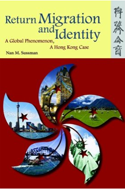Member Publications
Return Migration and Identity: A Global Phenomenon, A Hong Kong Case

Author(s) Nan M. Sussman
2010, Hong Kong University Press
Tags Acculturation, Migration
Price HDK225, $30 | Pages 364 | ISBN 9789888028849
The global trend for immigrants to return home has unique relevance for Hong Kong. This work of cross-cultural psychology explores many personal stories of return migration. The author captures in dozens of interviews the anxieties, anticipations, hardships and flexible world perspectives of migrants and their families as well as friends and co-workers.
The book examines cultural identity shifts and population flows during a critical juncture in Hong Kong history between the Sino-British Joint Declaration in 1984 and the early years of Hong Kong’s new status as a special administrative region after 1997. Nearly a million residents of Hong Kong migrated to North America, Europe and Australia in the 1990s. These interviews and analyses help illustrate individual choices and identity profiles during this period of unusual cultural flexibility and behavioral adjustment.
Table of Contents
ntroduction. “Anna” migrates and returns home
Chapter 1. A short history of two hundred years of Hong Kong migration and identity
Chapter 2. Sojourner adjustment and adaptation to new cultures: Art, literature, and the social science perspective on identity
Chapter 3. Returning home: Cultural transitions and the identity model
Chapter 4. Results from the Hong Kong Remigration Project: Departing, adjusting, returning
Chapter 5. Additive identity
Chapter 6. Subtractive identity
Chapter 7. Global and affirmative identities
Chapter 8. Remigrants and family life
Chapter 9. Remigrants and professional life
Chapter 10. Confucius and Socrates: Ancient philosophies, migration, and cultural identity
Chapter 11. The new Hong Kong boomerang
Appendix A. Hong Kong Remigration Project questionnaire and psychological scales
Appendix B. Methods, sample, and qualitative analysis
Appendix C. Quantitative analysis
Appendix D. Demographic characteristics of research participants
